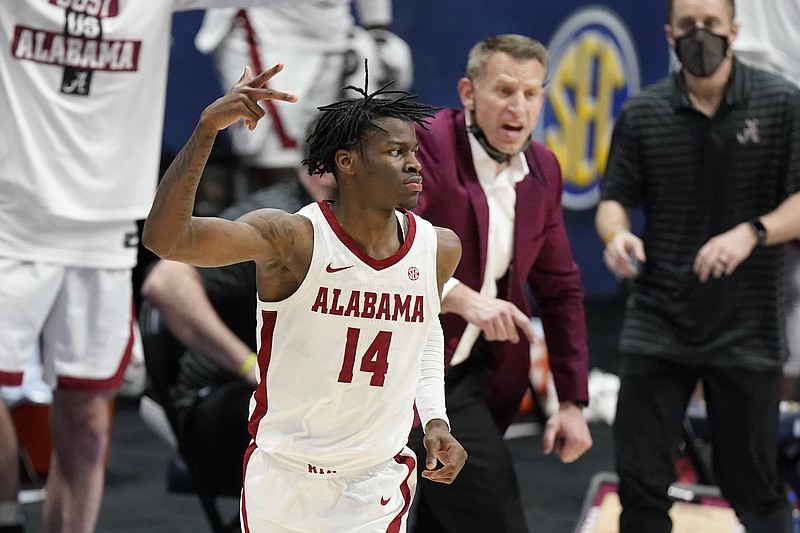INDIANAPOLIS - Nobody will get a lump in their throat or start sizing up glass slippers for the men's basketball programs at Alabama, Baylor or Illinois.
They're not underdogs. Their schools are anything but unknown. What they are is part of a new group of teams with well-recognized names in the NCAA tournament, and they hope to keep making life hard on some of the programs that have long had a stranglehold on surviving and thriving during March Madness.
Alabama (24-6) is the East Region's No. 2 seed - that matches the best seed in Crimson Tide history - after sweeping the Southeastern Conference's regular season and tournament titles, with the latter championship its first in three decades.
Baylor (22-2), building momentum for a while now, beat out Kansas for the Big 12's regular-season title despite a three-week break induced by the coronavirus. No. 1 in the South Region, the Bears are a top-seeded team for the first time.
Illinois (23-6), an NCAA tourney regular from the 1980s through the 2000s with five Final Four trips and a runner-up finish (2005), is in the 68-team bracket for the first time since 2013. The Fighting Illini, slotted into the Midwest Region, join a fellow Big Ten team with more postseason success of late, Michigan (20-4), as No. 1 seeds; the Wolverines are tops in the East Region, with Gonzaga (26-0) No. 1 both in the West and overall.
Illinois coach Brad Underwood, who took over four years ago, endured two losing seasons before showing major progress. Until then?
"I'd be lying if I said there weren't a lot of uh-oh moments," he said.
All these programs have, indeed, had their uh-oh moments over the years, which is what makes their rise notable.
Even before the pairings were announced, the pandemic ensured this NCAA tournament was going to be a much different affair. Then some dominos started falling. Duke and Kentucky, two longtime maestros of March, didn't even make the field of 68 - the first time that pair of basketball blue bloods has missed the tournament together since 1976.
Michigan State struggled. Kansas had a year not quite up to its standards. North Carolina's traditional late-season matchup against rival Duke was not for the Atlantic Coast Conference title but basically to keep its NCAA tournament chances alive.
Meanwhile in Alabama, the Tide was rolling, and it had nothing to do with Nick Saban. They make movies about the history of Alabama football. The history of Alabama basketball can be written on a postcard: Wimp Sanderson and his plaid sports coat, Robert Horry, one trip to the Elite Eight in 21 previous, mostly unmemorable visits to the tournament.
"They weren't terrible at basketball, and it seemed like they were on the verge of being a good basketball school," said Tide senior Herb Jones, a third-team All-American this year who is from Greensboro, Alabama. "It looked like the perfect place to come in and turn the narrative, and give kids from Alabama a place to play basketball instead of going out of state."
Illinois was a powerhouse once, but its most recent trip to the Final Four was in 2005, and that came nearly a decade after coach Lou Henson left and brought an end to a golden era for Illini hoops. Underwood said when he arrived, he did an informal poll of his players to start each season, asking them which team in the Big Ten plays the hardest.
"They would all say it's Michigan State. Michigan State, Michigan State, Michigan State," Underwood said. "Then, it was start of last year, before they finally figured out what I wanted to hear. They finally said us. They had to start believing that."
Michigan State, a 2019 Final Four team, slipped into the bracket this year as a No. 11 seed - and was put into one of Thursday's Final Four play-in pairings, facing 11-time NCAA champion UCLA in the fourth and final game. Syracuse, also seeded 11th, was another familiar name that took a little longer to find in this year's bracket.
Meanwhile, some other Power Five teams are finding themselves enjoying a new cachet: maybe not tournament regulars, but certainly not to be overlooked.
Rutgers is in for the first time since 1991. Its first-round opponent, Clemson, has been overshadowed by its school's football success in recent years. Another so-called football school, Florida State, is in its fifth season as a burgeoning hoops power in the ACC, coming in as a No. 4 seed after two straight trips to the Sweet 16.
Could this be the year a team like Florida State, Alabama or Baylor finally breaks through?
In some ways, it would feel like a repeat of the most recent tournament, in 2019, when Auburn, Virginia and Texas Tech made the Final Four. They were names everyone had heard of, just not always because they were winning in March.
